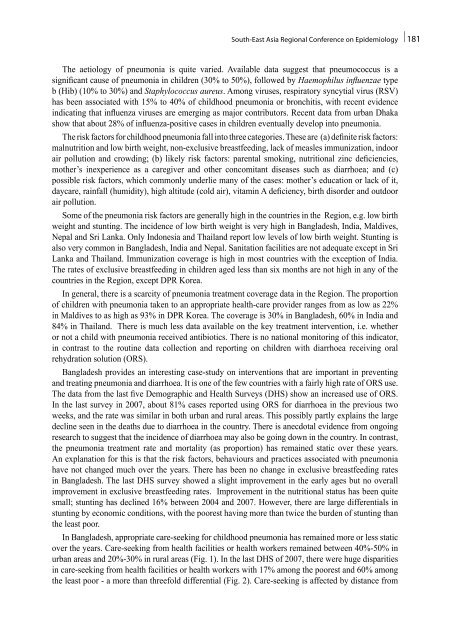South-East Asia Regional Conference on Epidemiology
South-East Asia Regional Conference on Epidemiology
South-East Asia Regional Conference on Epidemiology
Create successful ePaper yourself
Turn your PDF publications into a flip-book with our unique Google optimized e-Paper software.
<str<strong>on</strong>g>South</str<strong>on</strong>g>-<str<strong>on</strong>g>East</str<strong>on</strong>g> <str<strong>on</strong>g>Asia</str<strong>on</strong>g> <str<strong>on</strong>g>Regi<strong>on</strong>al</str<strong>on</strong>g> <str<strong>on</strong>g>C<strong>on</strong>ference</str<strong>on</strong>g> <strong>on</strong> <strong>Epidemiology</strong> | 181<br />
The aetiology of pneum<strong>on</strong>ia is quite varied. Available data suggest that pneumococcus is a<br />
significant cause of pneum<strong>on</strong>ia in children (30% to 50%), followed by Haemophilus influenzae type<br />
b (Hib) (10% to 30%) and Staphylococcus aureus. Am<strong>on</strong>g viruses, respiratory syncytial virus (RSV)<br />
has been associated with 15% to 40% of childhood pneum<strong>on</strong>ia or br<strong>on</strong>chitis, with recent evidence<br />
indicating that influenza viruses are emerging as major c<strong>on</strong>tributors. Recent data from urban Dhaka<br />
show that about 28% of influenza-positive cases in children eventually develop into pneum<strong>on</strong>ia.<br />
The risk factors for childhood pneum<strong>on</strong>ia fall into three categories. These are (a) definite risk factors:<br />
malnutriti<strong>on</strong> and low birth weight, n<strong>on</strong>-exclusive breastfeeding, lack of measles immunizati<strong>on</strong>, indoor<br />
air polluti<strong>on</strong> and crowding; (b) likely risk factors: parental smoking, nutriti<strong>on</strong>al zinc deficiencies,<br />
mother’s inexperience as a caregiver and other c<strong>on</strong>comitant diseases such as diarrhoea; and (c)<br />
possible risk factors, which comm<strong>on</strong>ly underlie many of the cases: mother’s educati<strong>on</strong> or lack of it,<br />
daycare, rainfall (humidity), high altitude (cold air), vitamin A deficiency, birth disorder and outdoor<br />
air polluti<strong>on</strong>.<br />
Some of the pneum<strong>on</strong>ia risk factors are generally high in the countries in the Regi<strong>on</strong>, e.g. low birth<br />
weight and stunting. The incidence of low birth weight is very high in Bangladesh, India, Maldives,<br />
Nepal and Sri Lanka. Only Ind<strong>on</strong>esia and Thailand report low levels of low birth weight. Stunting is<br />
also very comm<strong>on</strong> in Bangladesh, India and Nepal. Sanitati<strong>on</strong> facilities are not adequate except in Sri<br />
Lanka and Thailand. Immunizati<strong>on</strong> coverage is high in most countries with the excepti<strong>on</strong> of India.<br />
The rates of exclusive breastfeeding in children aged less than six m<strong>on</strong>ths are not high in any of the<br />
countries in the Regi<strong>on</strong>, except DPR Korea.<br />
In general, there is a scarcity of pneum<strong>on</strong>ia treatment coverage data in the Regi<strong>on</strong>. The proporti<strong>on</strong><br />
of children with pneum<strong>on</strong>ia taken to an appropriate health-care provider ranges from as low as 22%<br />
in Maldives to as high as 93% in DPR Korea. The coverage is 30% in Bangladesh, 60% in India and<br />
84% in Thailand. There is much less data available <strong>on</strong> the key treatment interventi<strong>on</strong>, i.e. whether<br />
or not a child with pneum<strong>on</strong>ia received antibiotics. There is no nati<strong>on</strong>al m<strong>on</strong>itoring of this indicator,<br />
in c<strong>on</strong>trast to the routine data collecti<strong>on</strong> and reporting <strong>on</strong> children with diarrhoea receiving oral<br />
rehydrati<strong>on</strong> soluti<strong>on</strong> (ORS).<br />
Bangladesh provides an interesting case-study <strong>on</strong> interventi<strong>on</strong>s that are important in preventing<br />
and treating pneum<strong>on</strong>ia and diarrhoea. It is <strong>on</strong>e of the few countries with a fairly high rate of ORS use.<br />
The data from the last five Demographic and Health Surveys (DHS) show an increased use of ORS.<br />
In the last survey in 2007, about 81% cases reported using ORS for diarrhoea in the previous two<br />
weeks, and the rate was similar in both urban and rural areas. This possibly partly explains the large<br />
decline seen in the deaths due to diarrhoea in the country. There is anecdotal evidence from <strong>on</strong>going<br />
research to suggest that the incidence of diarrhoea may also be going down in the country. In c<strong>on</strong>trast,<br />
the pneum<strong>on</strong>ia treatment rate and mortality (as proporti<strong>on</strong>) has remained static over these years.<br />
An explanati<strong>on</strong> for this is that the risk factors, behaviours and practices associated with pneum<strong>on</strong>ia<br />
have not changed much over the years. There has been no change in exclusive breastfeeding rates<br />
in Bangladesh. The last DHS survey showed a slight improvement in the early ages but no overall<br />
improvement in exclusive breastfeeding rates. Improvement in the nutriti<strong>on</strong>al status has been quite<br />
small; stunting has declined 16% between 2004 and 2007. However, there are large differentials in<br />
stunting by ec<strong>on</strong>omic c<strong>on</strong>diti<strong>on</strong>s, with the poorest having more than twice the burden of stunting than<br />
the least poor.<br />
In Bangladesh, appropriate care-seeking for childhood pneum<strong>on</strong>ia has remained more or less static<br />
over the years. Care-seeking from health facilities or health workers remained between 40%-50% in<br />
urban areas and 20%-30% in rural areas (Fig. 1). In the last DHS of 2007, there were huge disparities<br />
in care-seeking from health facilities or health workers with 17% am<strong>on</strong>g the poorest and 60% am<strong>on</strong>g<br />
the least poor - a more than threefold differential (Fig. 2). Care-seeking is affected by distance from









